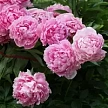
Paeonia
Catchy flower
| Latin name | Paeonia |
| Homeland | Asia |
| Family | Paeoniaceae |
| Cultivation | simple, long-term |
| Location | penumbra |
| Temperature | 15-20 °C, can withstand up to -25 °C |
| Watering | in high season, frequent |
| Flowering time | spring-summer |
| Height | depending on the view 30 cm - 1 m |
| Transplanting | avoid |
| Appearance maintenance | remove dry branches in March-April |
The genus Peony (Paeonia) includes about 40 perennial herbaceous or shrubby species of various origins. Most of them are from Asia, particularly from China and Tibet, and today they grow wild in Europe. The leaves are large, cuttings, twice and thrice dissected. Peonies form simple or double, spherical or flattened flowers of various colors. Today, there are plants whose flowers are colored in colors from white to yellow, red and cream, often they have stripes and spots. Some types and cultivars (this term refers to varieties that have been bred from cultivated plants) form fragrant flowers. Milk-flowered peony (Paeonia lactiflora) is one of the most common species; white, red, pink and orange Chinese peonies with very long blooms are derived from it. The fragrant yellow peony (P. luteuss) and medicinal peony (P. officinalis) originated from the European Mediterranean. The semi-shrub peony (P. suffruticosa) is the most typical of the shrubby species, with large white flowers, the petals of which are covered with pink and purple spots at the base.
The genus Peony (Paeonia) includes about 40 perennial herbaceous or shrubby species of various origins. Most of them are from Asia, particularly from China and Tibet, and today they grow wild in Europe. The leaves are large, cuttings, twice and thrice dissected. Peonies form simple or double, spherical or flattened flowers of various colors. Today, there are plants whose flowers are colored in colors from white to yellow, red and cream, often they have stripes and spots. Some types and cultivars (this term refers to varieties that have been bred from cultivated plants) form fragrant flowers.
Milk-flowered peony (Paeonia lactiflora) is one of the most common species; white, red, pink and orange Chinese peonies with very long blooms are derived from it.
The fragrant yellow peony (P. luteuss) and medicinal peony (P. officinalis) originated from the European Mediterranean.
The semi-shrub peony (P. suffruticosa) is the most typical of the shrubby species, with large white flowers, the petals of which are covered with pink and purple spots at the base.
Cultivation
The soil for peonies should be rich in organic substances, with a low lime content. It is recommended to top up with rotted cow manure. Perennial herbaceous species are planted to a depth of 3-5 cm, shrubby-7-8 cm. The latter grow well in a limited amount of soil in a pot, but they, like all peonies, cannot be grown indoors.
Location
Peonies do not like the sun, so to make them bloom well, it is preferable to keep them in a cool, partially shaded place. The humidity should be moderately high and the soil well drained.
Temperature
For peonies, the ideal temperature is in the range of 15-20 °C, and many species tolerate lower temperatures (up to -25 °C).
Watering
These plants require a lot of water. For good flowering, you need abundant watering, especially in long-term dry weather.
Transplant
Peonies do not like transplanting very much: both in the open ground and from pot to pot. The soil, even in a pot, should be maximally enriched with organic substances and with a minimum lime content. Herbaceous species are recommended to be planted to a depth of 3-5 cm, shrubby-up to 7-8 cm.
Care
At the end of flowering, the flowers are removed. In herbaceous species, the leaves are cut off at the beginning of winter.
Reproduction
Seed propagation is little practiced due to the fact that cultivars and hybrids in this case lose their characteristic features. Therefore, it is preferable to use the division of the bush. Herbaceous species can also be propagated by parts of the rhizome that are 5-6 cm long and have at least one bud. Shrubby species are propagated by cuttings or dividing the bush, giving preference to the most lush plants.
Diseases
Gray rot causes spots on the leaves and lower part of the stem. The affected areas turn brown and dry out. Plants are treated with a special fungicide. Peony roots are damaged by Hepialus lupulinus-its caterpillars gnaw at the roots, and the plant dies. Stamens, pistils and buds are affected by golden bronze (Cetonia aurata). Roots and leaves can be damaged by Aphelencoides fragariae and Aphelencoides rizema-bosi, which causes yellow spots on the leaves and leads to root rot. In these cases, it is recommended to resort to special medications.
Acquisition
Peonies do not tolerate transplanting very well: both in the open ground and from pot to pot. Therefore, when choosing a purchased plant, you should pay attention to whether it is well formed and whether it can be planted directly in a permanent place.